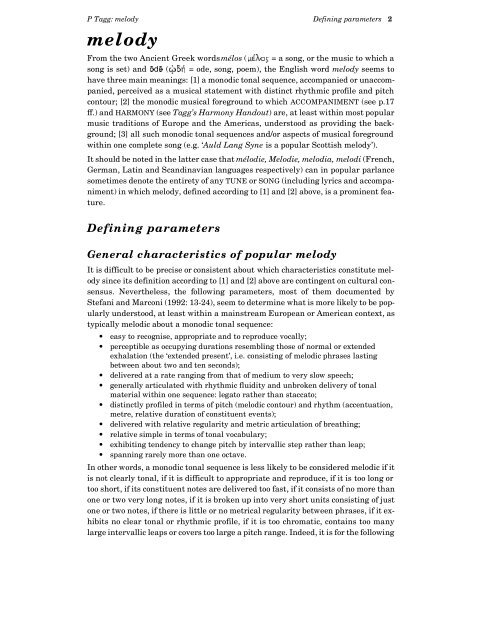Melody and Accompaniment - Philip Tagg
Melody and Accompaniment - Philip Tagg
Melody and Accompaniment - Philip Tagg
You also want an ePaper? Increase the reach of your titles
YUMPU automatically turns print PDFs into web optimized ePapers that Google loves.
P <strong>Tagg</strong>: melody Defining parameters 2<br />
melody<br />
From the two Ancient Greek words (m°low mélos = a song, or the music to which a<br />
song is set) ode (”dÆ <strong>and</strong> = ode, song, poem), the English word melody seems to<br />
have three main meanings: [1] a monodic tonal sequence, accompanied or unaccompanied,<br />
perceived as a musical statement with distinct rhythmic profile <strong>and</strong> pitch<br />
contour; [2] the monodic musical foreground to which ACCOMPANIMENT (see p.17<br />
ff.) <strong>and</strong> HARMONY (see <strong>Tagg</strong>’s Harmony H<strong>and</strong>out) are, at least within most popular<br />
music traditions of Europe <strong>and</strong> the Americas, understood as providing the background;<br />
[3] all such monodic tonal sequences <strong>and</strong>/or aspects of musical foreground<br />
within one complete song (e.g. ‘Auld Lang Syne is a popular Scottish melody’).<br />
It should be noted in the latter case that mélodie, Melodie, melodia, melodi (French,<br />
German, Latin <strong>and</strong> Sc<strong>and</strong>inavian languages respectively) can in popular parlance<br />
sometimes denote the entirety of any TUNE or SONG (including lyrics <strong>and</strong> accompaniment)<br />
in which melody, defined according to [1] <strong>and</strong> [2] above, is a prominent feature.<br />
Defining parameters<br />
General characteristics of popular melody<br />
It is difficult to be precise or consistent about which characteristics constitute melody<br />
since its definition according to [1] <strong>and</strong> [2] above are contingent on cultural consensus.<br />
Nevertheless, the following parameters, most of them documented by<br />
Stefani <strong>and</strong> Marconi (1992: 13-24), seem to determine what is more likely to be popularly<br />
understood, at least within a mainstream European or American context, as<br />
typically melodic about a monodic tonal sequence:<br />
• easy to recognise, appropriate <strong>and</strong> to reproduce vocally;<br />
• perceptible as occupying durations resembling those of normal or extended<br />
exhalation (the ‘extended present’, i.e. consisting of melodic phrases lasting<br />
between about two <strong>and</strong> ten seconds);<br />
• delivered at a rate ranging from that of medium to very slow speech;<br />
• generally articulated with rhythmic fluidity <strong>and</strong> unbroken delivery of tonal<br />
material within one sequence: legato rather than staccato;<br />
• distinctly profiled in terms of pitch (melodic contour) <strong>and</strong> rhythm (accentuation,<br />
metre, relative duration of constituent events);<br />
• delivered with relative regularity <strong>and</strong> metric articulation of breathing;<br />
• relative simple in terms of tonal vocabulary;<br />
• exhibiting tendency to change pitch by intervallic step rather than leap;<br />
• spanning rarely more than one octave.<br />
In other words, a monodic tonal sequence is less likely to be considered melodic if it<br />
is not clearly tonal, if it is difficult to appropriate <strong>and</strong> reproduce, if it is too long or<br />
too short, if its constituent notes are delivered too fast, if it consists of no more than<br />
one or two very long notes, if it is broken up into very short units consisting of just<br />
one or two notes, if there is little or no metrical regularity between phrases, if it exhibits<br />
no clear tonal or rhythmic profile, if it is too chromatic, contains too many<br />
large intervallic leaps or covers too large a pitch range. Indeed, it is for the following














